#Computer Network Tutorial for Beginners
Explore tagged Tumblr posts
Text
Computer Network Basics: A Beginner’s Tutorial with Examples

Learn computer networking basics with this easy tutorial for beginners. Understand network types, components, and how data flows. Perfect for students and beginners starting their networking journey!
0 notes
Text
The Complete Manual for Understanding Ethical Hacking
In order to evaluate an organization's defenses, ethical hacking—also referred to as penetration testing or white-hat hacking—involves breaking into computers and other devices lawfully. You've come to the correct spot if you're interested in finding out more about ethical hacking. Here's a quick start tutorial to get you going.

1. "Getting Started with the Basics"
Networking and computer science principles must be thoroughly understood before getting into ethical hacking. Here are some crucial aspects to pay attention to: Operating Systems: Acquire knowledge of several operating systems, with a focus on Linux and Windows. Learning Linux is essential because a lot of hacking tools are made to run on it. Networking: It's essential to comprehend how networks operate. Find out more about
protocols include HTTP, HTTPS, DNS, TCP/IP, and others. Understanding data flow across networks facilitates vulnerability detection. Programming: It's crucial to know at least a little bit of a language like Python, JavaScript, or C++. Writing scripts and deciphering the code of pre-existing tools are made possible by having programming expertise.
2. Making Use of Internet Resources To learn more about ethical hacking, there are a ton of internet resources available. Here are a few of the top ones: Online Education: Online learning environments such as Pluralsight, Coursera, and Udemy provide in-depth instruction in ethical hacking. "Penetration Testing and Ethical Hacking" on Pluralsight and "The Complete Ethical Hacking Course: Beginner to Advanced" on Udemy are two recommended courses. Channels on YouTube: HackerSploit, The Cyber Mentor, and LiveOverflow are just a few of the channels that offer helpful tutorials and walkthroughs on a variety of hacking tactics.
3. Exercising and Acquiring Knowledge The secret to being a skilled ethical hacker is experience. Here are some strategies to obtain practical experience:
Capture the Flag (CTF) Tournaments: Applying your abilities in CTF tournaments is a great idea. CTF challenges are available on websites like CTFtime and OverTheWire, with difficulty levels ranging from novice to expert. Virtual Labs: It is essential to set up your virtual lab environment. You can construct isolated environments to practice hacking without worrying about the law thanks to programs like VMware and VirtualBox. Bug Bounty Programs: Websites such as HackerOne and Bugcrowd link corporations seeking to find and address security holes in their systems with ethical hackers. Engaging in these initiatives can yield practical experience and financial benefits.

Dedication and ongoing education are necessary to learn ethical hacking. You can become a skilled ethical hacker by learning the fundamentals, using internet resources, and acquiring real-world experience. Always remember to hack wisely and ethically. Cheers to your hacking! I appreciate your precious time, and I hope you have an amazing day.
9 notes
·
View notes
Text
AWS Mastery Unveiled: Your Step-by-Step Journey into Cloud Proficiency
In today's rapidly evolving tech landscape, mastering cloud computing is a strategic move for individuals and businesses alike. Amazon Web Services (AWS), as a leading cloud services provider, offers a myriad of tools and services to facilitate scalable and efficient computing. With AWS Training in Hyderabad, professionals can gain the skills and knowledge needed to harness the capabilities of AWS for diverse applications and industries. Whether you're a seasoned IT professional or a beginner eager to dive into the cloud, here's a step-by-step guide to learning and mastering Amazon AWS.
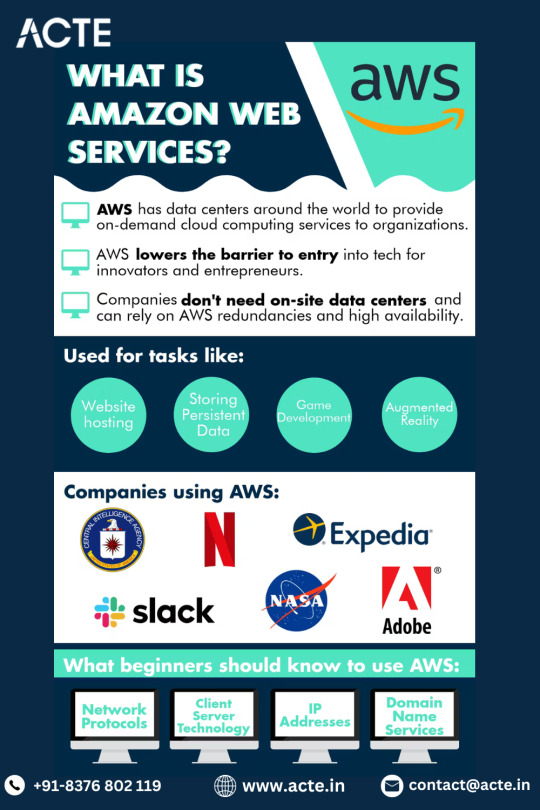
1. Start with AWS Documentation:
The foundation of your AWS journey begins with the official AWS documentation. This vast resource provides detailed information, tutorials, and guides for each AWS service. Take the time to familiarize yourself with the terminologies and fundamental concepts. Understanding the basics lays a solid groundwork for more advanced learning.
2. Enroll in AWS Training and Certification:
AWS provides a dedicated training and certification program to empower individuals with the skills required in today's cloud-centric environment. Explore the AWS Training and Certification portal, which offers a range of courses, both free and paid. Commence your AWS certification journey with the AWS Certified Cloud Practitioner, progressively advancing to specialized certifications aligned with your career goals.
3. Hands-On Practice with AWS Free Tier:
Theory is valuable, but hands-on experience is paramount. AWS Free Tier allows you to experiment with various services without incurring charges. Seize this opportunity to get practical, testing different services and scenarios. This interactive approach reinforces theoretical knowledge and builds your confidence in navigating the AWS console.
4. Explore Online Courses and Tutorials:
Several online platforms offer structured AWS courses. Websites like Coursera, Udemy, and A Cloud Guru provide video lectures, hands-on labs, and real-world projects. These courses cover a spectrum of topics, from foundational AWS concepts to specialized domains like AWS security and machine learning. To master the intricacies of AWS and unlock its full potential, individuals can benefit from enrolling in the Top AWS Training Institute. This training ensures that professionals gain the expertise needed to navigate the complexities of AWS, empowering them to contribute effectively to their organizations' digital transformation and success.
5. Build Projects and Apply Knowledge:
The true test of your AWS proficiency lies in applying your knowledge to real-world projects. Start small, perhaps by deploying a static website on Amazon S3. As you gain confidence, move on to more complex projects, such as configuring a virtual server on Amazon EC2 or creating a serverless application using AWS Lambda. Practical application solidifies your understanding and hones your problem-solving skills.
6. Join AWS Communities and Forums:
Learning is a collaborative effort. Joining AWS communities and forums allows you to connect with like-minded individuals, seek advice, and share your experiences. Platforms like the AWS Developer Forums provide a space for discussing challenges and learning from others' insights. Networking within the AWS community can open doors to valuable opportunities and collaborations.
7. Read AWS Whitepapers and Case Studies:
AWS regularly publishes whitepapers covering best practices, architecture recommendations, and real-world case studies. Delve into these resources to gain deeper insights into how AWS services are applied in diverse scenarios. Whitepapers provide a wealth of knowledge on topics such as security, scalability, and cost optimization.
8. Experiment with AWS CLI and SDKs:
Command Line Interface (CLI) proficiency is a valuable skill for any AWS practitioner. Familiarize yourself with the AWS CLI, as well as Software Development Kits (SDKs) for your preferred programming languages. Automating tasks through the CLI and integrating AWS services into your applications enhances efficiency and allows for more sophisticated configurations.
9. Attend AWS Events and Webinars:
Stay abreast of the latest AWS trends, updates, and best practices by attending AWS events, webinars, and conferences. These platforms often feature expert speakers, product announcements, and in-depth discussions on specific AWS topics. Engaging with industry leaders and experts provides valuable insights into the current state and future direction of AWS.
10. Stay Updated and Adapt:
The cloud computing landscape is dynamic, with AWS continually introducing new services and updates. Subscribe to AWS newsletters, follow AWS blogs, and listen to AWS-focused podcasts to stay informed about the latest developments. Continuous learning is key to adapting to the evolving cloud technology landscape.

In conclusion, mastering Amazon AWS is a journey that combines theoretical understanding, hands-on experience, and active participation in the AWS community. By following these ten steps, you can develop a comprehensive skill set that empowers you to leverage AWS effectively, whether you're building applications, optimizing processes, or advancing your career in the cloud.
2 notes
·
View notes
Text
From Math to Machine Learning: A Comprehensive Blueprint for Aspiring Data Scientists
The realm of data science is vast and dynamic, offering a plethora of opportunities for those willing to dive into the world of numbers, algorithms, and insights. If you're new to data science and unsure where to start, fear not! This step-by-step guide will navigate you through the foundational concepts and essential skills to kickstart your journey in this exciting field. Choosing the Best Data Science Institute can further accelerate your journey into this thriving industry.
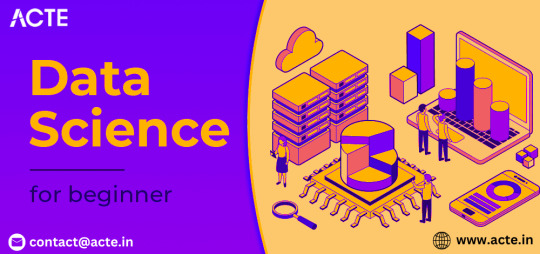
1. Establish a Strong Foundation in Mathematics and Statistics
Before delving into the specifics of data science, ensure you have a robust foundation in mathematics and statistics. Brush up on concepts like algebra, calculus, probability, and statistical inference. Online platforms such as Khan Academy and Coursera offer excellent resources for reinforcing these fundamental skills.
2. Learn Programming Languages
Data science is synonymous with coding. Choose a programming language – Python and R are popular choices – and become proficient in it. Platforms like Codecademy, DataCamp, and W3Schools provide interactive courses to help you get started on your coding journey.
3. Grasp the Basics of Data Manipulation and Analysis
Understanding how to work with data is at the core of data science. Familiarize yourself with libraries like Pandas in Python or data frames in R. Learn about data structures, and explore techniques for cleaning and preprocessing data. Utilize real-world datasets from platforms like Kaggle for hands-on practice.
4. Dive into Data Visualization
Data visualization is a powerful tool for conveying insights. Learn how to create compelling visualizations using tools like Matplotlib and Seaborn in Python, or ggplot2 in R. Effectively communicating data findings is a crucial aspect of a data scientist's role.
5. Explore Machine Learning Fundamentals
Begin your journey into machine learning by understanding the basics. Grasp concepts like supervised and unsupervised learning, classification, regression, and key algorithms such as linear regression and decision trees. Platforms like scikit-learn in Python offer practical, hands-on experience.
6. Delve into Big Data Technologies
As data scales, so does the need for technologies that can handle large datasets. Familiarize yourself with big data technologies, particularly Apache Hadoop and Apache Spark. Platforms like Cloudera and Databricks provide tutorials suitable for beginners.
7. Enroll in Online Courses and Specializations
Structured learning paths are invaluable for beginners. Enroll in online courses and specializations tailored for data science novices. Platforms like Coursera ("Data Science and Machine Learning Bootcamp with R/Python") and edX ("Introduction to Data Science") offer comprehensive learning opportunities.
8. Build Practical Projects
Apply your newfound knowledge by working on practical projects. Analyze datasets, implement machine learning models, and solve real-world problems. Platforms like Kaggle provide a collaborative space for participating in data science competitions and showcasing your skills to the community.
9. Join Data Science Communities
Engaging with the data science community is a key aspect of your learning journey. Participate in discussions on platforms like Stack Overflow, explore communities on Reddit (r/datascience), and connect with professionals on LinkedIn. Networking can provide valuable insights and support.
10. Continuous Learning and Specialization
Data science is a field that evolves rapidly. Embrace continuous learning and explore specialized areas based on your interests. Dive into natural language processing, computer vision, or reinforcement learning as you progress and discover your passion within the broader data science landscape.
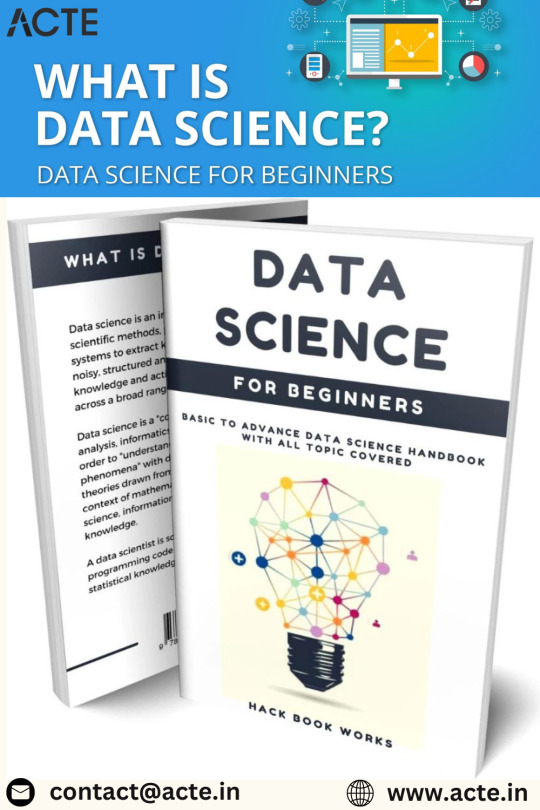
Remember, your journey in data science is a continuous process of learning, application, and growth. Seek guidance from online forums, contribute to discussions, and build a portfolio that showcases your projects. Choosing the best Data Science Courses in Chennai is a crucial step in acquiring the necessary expertise for a successful career in the evolving landscape of data science. With dedication and a systematic approach, you'll find yourself progressing steadily in the fascinating world of data science. Good luck on your journey!
3 notes
·
View notes
Text
Exploring Python - A Perfect Easy Language Choice for Beginners
Python is a popular programming language, and it's particularly known for being easy to grasp. But why is Python a common recommendation, especially for people who are new to programming?
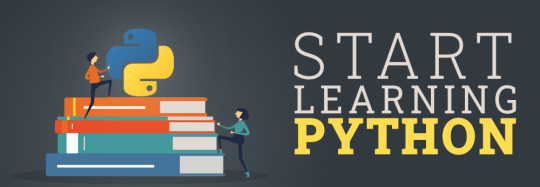
1. Language That Reads Like English:
Python stands out because when you read Python code, it looks a lot like the English language. It doesn't use complex symbols or strange commands. Instead, Python uses words and phrases that you're already familiar with.
2. Emphasis on Easy Reading:
Python places a strong emphasis on making code easy to read. This means that not only is your code easy for you to understand, but it's also simple for others who might work on your code. This focus on readability is like having a friendly guide that helps everyone who deals with the code.
3. Plenty of Learning Help:
Starting something new can often be intimidating, but Python makes the learning process more accessible. There's a wealth of resources available to help you learn Python. These resources include official documentation, tutorials, online courses, and forums. It's like having guidebooks, teachers, and fellow learners who are ready to assist you. Python's vast learning support network ensures you're never alone on your learning journey.
4. Super Flexible:
Python is an incredibly versatile programming language used in various domains. It's employed in web development, data analysis, artificial intelligence, and more. Learning Python opens doors to a wide range of career opportunities, just like a master key unlocks many doors.
5. A Library of Shortcuts:
Python boasts an extensive standard library that includes pre-written code for various common tasks. This is like having a collection of shortcuts to simplify everyday coding tasks. These pre-written pieces of code can save you a great deal of time and effort when you're building applications.
6. A Crowd of Friends:
Python has a vast and active community of developers. These Python enthusiasts hang out online, answering questions, sharing tips, and making sure you're never stranded for too long when you encounter programming challenges. It's like being part of a giant, friendly classroom where help is always at hand.
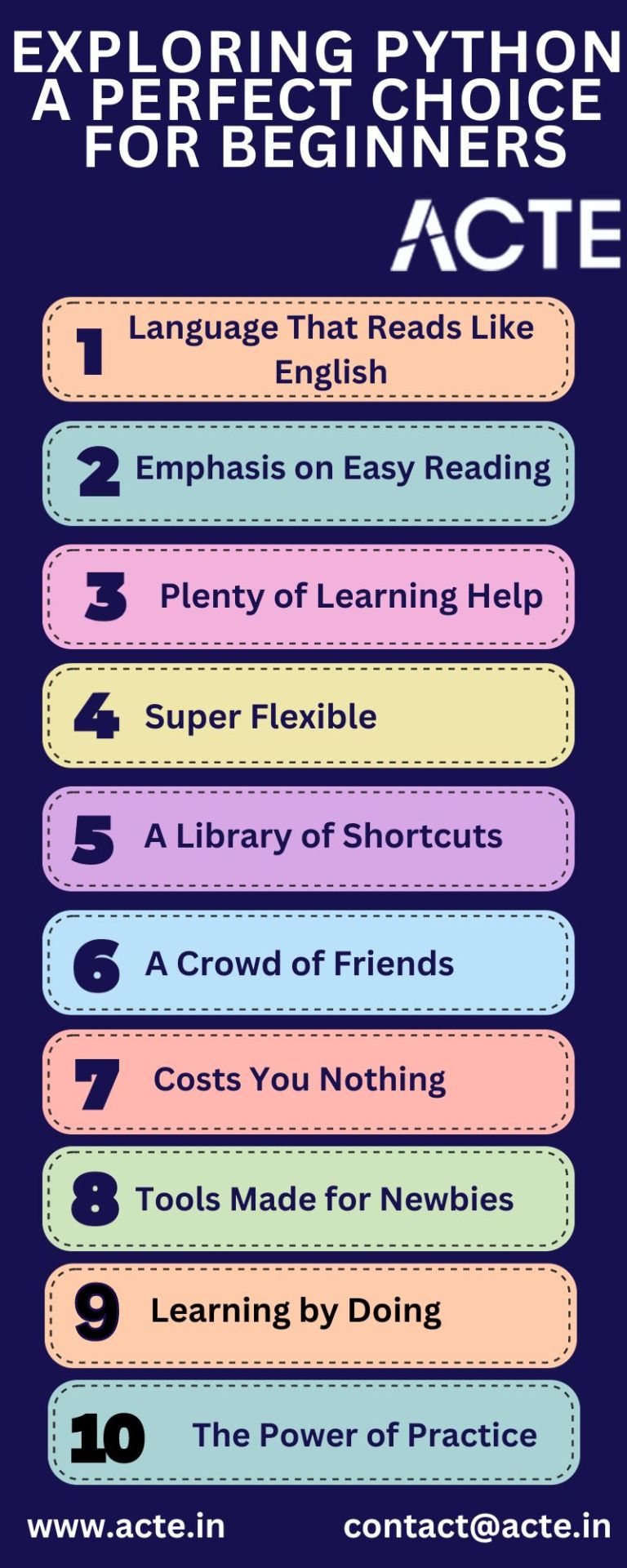
7. Costs You Nothing:
Learning Python doesn't come with a price tag. Python is open-source, which means it's entirely free to use. You can download and install Python on your computer without spending any money, similar to finding a cool toy without having to make a purchase.
8. Tools Made for Newbies:
Python also offers beginner-friendly integrated development environments (IDEs) like IDLE and user-friendly code editors like Visual Studio Code. These tools are designed to make the coding process simpler and less intimidating for beginners, much like having training wheels on your first bicycle.
9. Learning by Doing:
Python strongly encourages hands-on learning. It's similar to learning to cook by actually cooking. With Python, you can start writing and executing code right away, gaining practical experience that accelerates your progress.
10. The Power of Practice:
While Python's simplicity is a significant advantage for beginners, mastering any programming language still requires practice. It's comparable to learning to play a musical instrument. You might hit a few wrong notes at first, but with practice, you'll play beautiful music.
In summary, Python is not tough to learn, especially for beginners. Its user-friendly syntax, readability, extensive resources, and supportive community make it an excellent choice for those starting their programming journey. Remember, with dedication and practice, you can master Python and open doors to a world of coding possibilities.
If you're eager to start your Python learning journey, consider exploring the Python courses and certifications offered by ACTE Technologies. Their expert instructors and comprehensive curriculum can provide you with the guidance and knowledge you need to become proficient in Python.
2 notes
·
View notes
Text
How to Begin Your Web Design Journey: A Step-by-Step Guide in Simple Terms

Understanding the Basics:
Learn about HTML, which is like a web page’s skeleton.
Understand CSS, which is like makeup for web pages.
Know how to make websites look good on different screens.
2. Choose your tools:
Start with simple text editors like Notepad (for Windows) or TextEdit (for Mac).
Later, try fancier editors like Visual Studio Code.
For making pictures, try Adobe Photoshop or Illustrator.
3. Learn HTML and CSS:
Use websites like W3Schools or Codecademy.
If you want to learn more about web design with certification and placement, ACTE Institute offers comprehensive machine learning training courses that can give you the knowledge and skills necessary to excel in this field. Consider the infinite possibilities for data analysis, automation, and decision-making that machine learning may create.
YouTube: There are many video tutorials covering HTML and CSS for beginners.
They teach you how to make web pages and make them look nice.
You can also learn from courses on Coursera or edX.
4. Practice your skills.
Besides learning, make simple web pages to get better.
Try harder projects as you get more confident.
Make your own website to practice lots.
5. Responsive Web Design:
Make sure your websites work well on phones and computers.
Learn about media queries (they help your design fit different screens).
6. Master CSS Layouts:
Get really good at arranging web stuff using CSS (like making boxes and arranging them nicely).
7. Web Design Frameworks:
Think about using ready-made kits like Bootstrap.
They have pre-made pieces to help you design faster.
8. UI/UX Design:
Learn to make websites easy to use and nice to look at.
Think about how people will use your site.
9. Web Hosting and Domain:
To show your website to people, you need a place to put it (hosting) and a name for it (domain).
Lots of companies can help with this, like Bluehost or HostGator.
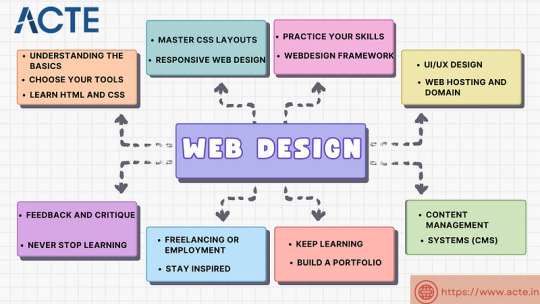
10. Content Management Systems (CMS):
Consider using tools like WordPress to manage your website easily.
11. Keep Learning:
Web design keeps changing, so keep learning new stuff.
Read blogs, watch webinars, and take more advanced classes.
12. Build a portfolio.
Make a collection of your best work to show others.
People who might hire you want to see what you can do.
13. Freelancing or employment:
Decide if you want to work alone or with a company.
Both ways have good things and not-so-good things, so pick what you like.
14. Networking:
Join groups of web designers to meet others like you.
Learning from others can help you become better.
15. Feedback and criticism:
Don’t be shy to ask for advice on your work.
When people give you tips, it helps you improve.
16. Launch your projects:
When you’re good enough, work on real websites.
Offer to make websites for friends or local businesses.
17. Stay Inspired:
Be creative and get ideas from different places.
Nature, art, and other designers can help you think of cool stuff.
18. Never Stop Learning:
Web design always changes, so keep learning new things.
Stay curious and open to learning more tricks and tools.
The secret to success in web design is to start with the fundamentals and gradually advance your abilities. Keep in mind that on this trip, patience and practice are the keys to success. As your skills advance, you’ll have the imagination needed to realise your ideas for websites. So put your hands in your pockets, launch your preferred coding editor, and start your web design experience!
4 notes
·
View notes
Text
Beginner’s Python PyTorch Tutorial: Start Your AI Journey Today
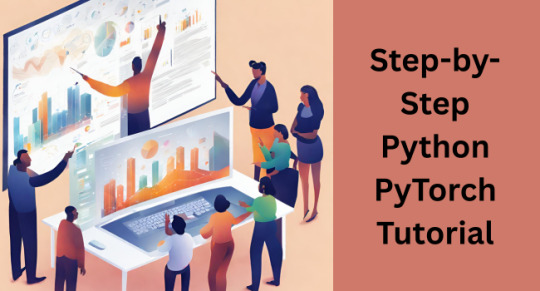
If you are interested in learning deep learning and artificial intelligence, then this Python PyTorch Tutorial is perfect for you. PyTorch is a popular open-source library used for machine learning and deep learning projects. It is developed by Facebook and widely used by researchers, developers, and data scientists.
This tutorial is made especially for beginners who want to understand the basics of deep learning. PyTorch is known for its simple and flexible design. It allows you to build, train, and test deep learning models with ease. One of the best features of PyTorch is its dynamic computational graph, which means you can change things on the go while building models.
In this Python PyTorch Tutorial, you will learn how PyTorch works, what tensors are, and how neural networks are created using this powerful library. The tutorial also covers important concepts like model training, loss functions, and optimizers—all explained in simple language.
Whether you want to build image recognition models, natural language processing applications, or any AI-related project, PyTorch is a great choice. Its clean syntax and helpful tools make learning deep learning less complicated for beginners.
If you are just starting out, don’t worry! This tutorial breaks down every concept in an easy-to-understand way. Begin your AI journey today with PyTorch.
To learn more and continue your learning, visit the Python PyTorch Tutorial
0 notes
Text
Kubernetes Tutorials | Waytoeasylearn
Learn how to become a Certified Kubernetes Administrator (CKA) with this all-in-one Kubernetes course. It is suitable for complete beginners as well as experienced DevOps engineers. This practical, hands-on class will teach you how to understand Kubernetes architecture, deploy and manage applications, scale services, troubleshoot issues, and perform admin tasks. It covers everything you need to confidently pass the CKA exam and run containerized apps in production.
Learn Kubernetes the easy way! 🚀 Best tutorials at Waytoeasylearn for mastering Kubernetes and cloud computing efficiently.➡️ Learn Now

Whether you are studying for the CKA exam or want to become a Kubernetes expert, this course offers step-by-step lessons, real-life examples, and labs focused on exam topics. You will learn from Kubernetes professionals and gain skills that employers are looking for.
Key Learning Outcomes: Understand Kubernetes architecture, components, and key ideas. Deploy, scale, and manage containerized apps on Kubernetes clusters. Learn to use kubectl, YAML files, and troubleshoot clusters. Get familiar with pods, services, deployments, volumes, namespaces, and RBAC. Set up and run production-ready Kubernetes clusters using kubeadm. Explore advanced topics like rolling updates, autoscaling, and networking. Build confidence with real-world labs and practice exams. Prepare for the CKA exam with helpful tips, checklists, and practice scenarios.
Who Should Take This Course: Aspiring CKA candidates. DevOps engineers, cloud engineers, and system admins. Software developers moving into cloud-native work. Anyone who wants to master Kubernetes for real jobs.
1 note
·
View note
Text
Cryptocurrency Mining Tutorials for Beginners quidminer.com
Cryptocurrency mining tutorials for beginners quidminer.com can be a great starting point for anyone looking to delve into the world of digital currency extraction. Understanding the basics is crucial before embarking on this journey. Firstly, it's important to know that cryptocurrency mining involves using computer hardware to solve complex mathematical problems that validate transactions on a blockchain network. This process not only secures the network but also rewards miners with new coins.
For beginners, choosing the right mining hardware is essential. Options range from CPUs and GPUs to more specialized ASICs (Application-Specific Integrated Circuits). Each has its own set of advantages and drawbacks in terms of cost, efficiency, and ease of use. Additionally, joining a mining pool can increase your chances of earning rewards by combining computational power with other miners.
To get started, visit resources like https://paladinmining.com for comprehensive guides and tools. These platforms offer insights into the latest mining techniques, software, and even calculators to estimate potential earnings. Remember, while cryptocurrency mining can be profitable, it also requires significant investment in equipment and energy. Therefore, thorough research and careful planning are vital steps towards successful mining operations. Stay updated with the latest trends and technologies to maximize your returns in this dynamic field.
quidminer.com

PaladinMining
Paladin Mining
0 notes
Text
Docker Tutorial for Beginners: Learn Docker Step by Step
What is Docker?
Docker is an open-source platform that enables developers to automate the deployment of applications inside lightweight, portable containers. These containers include everything the application needs to run—code, runtime, system tools, libraries, and settings—so that it can work reliably in any environment.
Before Docker, developers faced the age-old problem: “It works on my machine!” Docker solves this by providing a consistent runtime environment across development, testing, and production.
Why Learn Docker?
Docker is used by organizations of all sizes to simplify software delivery and improve scalability. As more companies shift to microservices, cloud computing, and DevOps practices, Docker has become a must-have skill. Learning Docker helps you:
Package applications quickly and consistently
Deploy apps across different environments with confidence
Reduce system conflicts and configuration issues
Improve collaboration between development and operations teams
Work more effectively with modern cloud platforms like AWS, Azure, and GCP
Who Is This Docker Tutorial For?
This Docker tutorial is designed for absolute beginners. Whether you're a developer, system administrator, QA engineer, or DevOps enthusiast, you’ll find step-by-step instructions to help you:
Understand the basics of Docker
Install Docker on your machine
Create and manage Docker containers
Build custom Docker images
Use Docker commands and best practices
No prior knowledge of containers is required, but basic familiarity with the command line and a programming language (like Python, Java, or Node.js) will be helpful.
What You Will Learn: Step-by-Step Breakdown
1. Introduction to Docker
We start with the fundamentals. You’ll learn:
What Docker is and why it��s useful
The difference between containers and virtual machines
Key Docker components: Docker Engine, Docker Hub, Dockerfile, Docker Compose
2. Installing Docker
Next, we guide you through installing Docker on:
Windows
macOS
Linux
You’ll set up Docker Desktop or Docker CLI and run your first container using the hello-world image.
3. Working with Docker Images and Containers
You’ll explore:
How to pull images from Docker Hub
How to run containers using docker run
Inspecting containers with docker ps, docker inspect, and docker logs
Stopping and removing containers
4. Building Custom Docker Images
You’ll learn how to:
Write a Dockerfile
Use docker build to create a custom image
Add dependencies and environment variables
Optimize Docker images for performance
5. Docker Volumes and Networking
Understand how to:
Use volumes to persist data outside containers
Create custom networks for container communication
Link multiple containers (e.g., a Node.js app with a MongoDB container)
6. Docker Compose (Bonus Section)
Docker Compose lets you define multi-container applications. You’ll learn how to:
Write a docker-compose.yml file
Start multiple services with a single command
Manage application stacks easily
Real-World Examples Included
Throughout the tutorial, we use real-world examples to reinforce each concept. You’ll deploy a simple web application using Docker, connect it to a database, and scale services with Docker Compose.
Example Projects:
Dockerizing a static HTML website
Creating a REST API with Node.js and Express inside a container
Running a MySQL or MongoDB database container
Building a full-stack web app with Docker Compose
Best Practices and Tips
As you progress, you’ll also learn:
Naming conventions for containers and images
How to clean up unused images and containers
Tagging and pushing images to Docker Hub
Security basics when using Docker in production
What’s Next After This Tutorial?
After completing this Docker tutorial, you’ll be well-equipped to:
Use Docker in personal or professional projects
Learn Kubernetes and container orchestration
Apply Docker in CI/CD pipelines
Deploy containers to cloud platforms
Conclusion
Docker is an essential tool in the modern developer's toolbox. By learning Docker step by step in this beginner-friendly tutorial, you’ll gain the skills and confidence to build, deploy, and manage applications efficiently and consistently across different environments.
Whether you’re building simple web apps or complex microservices, Docker provides the flexibility, speed, and scalability needed for success. So dive in, follow along with the hands-on examples, and start your journey to mastering containerization with Docker tpoint-tech!
0 notes
Text
Australia Gold Ore Mining +TG@yuantou2048
Australia Gold Ore Mining +TG@yuantou2048 is a fascinating topic that intertwines the traditional concept of mining with the modern world of cryptocurrency. In the digital age, "mining" has taken on a new meaning, especially with the advent of virtual currencies. Just as gold ore is extracted from the earth in Australia, digital miners extract cryptocurrencies through complex computational processes.
Virtual coin mining involves using high-powered computers to solve intricate mathematical problems. Once these problems are solved, new coins are generated and added to the blockchain, a public ledger that records all transactions. This process not only creates new coins but also verifies transactions within the network, ensuring its security and integrity.
For aspiring miners, platforms like https://paladinmining.com offer comprehensive resources and tools to get started. These platforms provide the necessary software and hardware recommendations, making it easier for beginners to join the mining community. Moreover, they often include tutorials and guides that explain the intricacies of mining, helping users optimize their operations for maximum profitability.
However, it's crucial to understand the challenges involved. Virtual coin mining requires significant investment in hardware and consumes a substantial amount of electricity. Therefore, miners must carefully analyze the costs and potential returns before diving in. Additionally, staying updated with the latest trends and technologies in the crypto space can give miners a competitive edge.
In conclusion, Australia Gold Ore Mining +TG@yuantou2048 serves as an interesting parallel to the world of virtual coin mining. By leveraging platforms like https://paladinmining.com, individuals can explore this exciting field and potentially earn valuable cryptocurrencies. Whether you're a tech enthusiast or a seasoned investor, the world of virtual coin mining offers endless opportunities for those willing to delve into its complexities.
https://t.me/yuantou2048

BCC Mining
BCCMining
0 notes
Text
Bitcoin Mining with BCCMining.com
Bitcoin Mining with BCCMining.com is a lucrative venture for those looking to delve into the world of cryptocurrency. At https://bccmining.com, you'll find a comprehensive platform designed to help both novice and experienced miners maximize their profits.
The essence of Bitcoin mining lies in solving complex mathematical problems using high-performance computing hardware. This process not only secures the network but also rewards miners with newly minted Bitcoins. BCCMining.com offers state-of-the-art mining solutions, including access to powerful mining rigs and optimized software, ensuring that users can mine efficiently and effectively.
One of the key advantages of using BCCMining.com is its user-friendly interface. The platform provides detailed guides and tutorials, making it easier for beginners to get started. Additionally, the site offers real-time monitoring tools that allow miners to track their progress and earnings effortlessly.
Moreover, BCCMining.com emphasizes security and reliability. With robust security measures in place, users can rest assured that their investments are protected. The platform also boasts a strong community of miners who share tips and strategies, fostering a collaborative environment.
In conclusion, if you're interested in Bitcoin mining, BCCMining.com is an excellent choice. Visit https://bccmining.com today to start your journey towards profitable mining and become part of the exciting world of cryptocurrencies.
bccmining.com

BCCMining
BCC Mining
0 notes
Text
Ethereum Miner - paladinmining.com
Ethereum miner is a crucial component in the world of cryptocurrency, especially for those interested in mining Ethereum. Ethereum miners are responsible for verifying transactions and adding them to the blockchain, which is the backbone of the Ethereum network. By using specialized hardware and software, miners can earn Ether (ETH) as a reward for their computational efforts.
If you're looking to get started with Ethereum mining, it's important to understand the basics. You'll need a powerful computer or dedicated mining rig equipped with high-performance GPUs or ASICs. Additionally, you'll need to join a mining pool to increase your chances of earning rewards. One such reputable mining pool is Paladin Mining, which offers a user-friendly platform and competitive payouts.
For more information on how to start mining Ethereum and to learn about the services offered by Paladin Mining, visit https://paladinmining.com. This website provides detailed guides, tutorials, and support for new and experienced miners alike. Whether you're a beginner or an advanced user, Paladin Mining has resources to help you maximize your mining potential and earn more ETH.
paladinmining.com

PaladinMining
Paladin Mining
0 notes
Text
What is Mining Bitcoins +blockchaincloudmining.com
Bitcoin mining is the process of verifying transactions on the Bitcoin network and adding them to the blockchain. Miners use powerful computers to solve complex mathematical puzzles, which are essentially a proof of work that secures the network and confirms new transactions. When a miner successfully solves a puzzle, they get rewarded with newly generated bitcoins and transaction fees.
To start mining, you need specialized hardware known as an ASIC (Application-Specific Integrated Circuit) miner, which is designed specifically for mining cryptocurrencies like Bitcoin. Additionally, miners often join mining pools to increase their chances of earning rewards by combining their computing power.
If you're interested in learning more about Bitcoin mining or want to start mining yourself, you can visit https://blockchaincloudmining.com for detailed guides, tutorials, and the latest news in the world of cryptocurrency mining. This website provides comprehensive information on cloud mining services, making it easier for both beginners and experienced miners to navigate the complex world of blockchain technology.
blockchaincloudmining.com

Block Chain Cloud Mining
BlockChain Cloud Mining
0 notes
Text
youtube
Deep Learning vs Machine Learning Explained So Easily! Deep Learning vs Machine Learning | #deeplearning #machinelearning #aiexplained Ever wondered how Netflix knows what show you'll like next, or how self-driving cars can spot people on the road? It all comes down to two big ideas in tech: Machine Learning and Deep Learning. In this video, we break down what they are, how they're different, and why they matter, in a way that's easy to understand. We'll explain how machine learning helps computers learn from data, like how your favorite app gives suggestions. Then we look at deep learning, which is like a more powerful version that uses neural networks to do even harder stuff, like recognizing faces or understanding speech. We use simple examples, real-life uses, and clear visuals so you can actually understand what’s going on. 👉 Subscribe for the latest AI news, comparisons, and reviews! 🔗 Stay Connected With Us. 🔔𝐃𝐨𝐧'𝐭 𝐟𝐨𝐫𝐠𝐞𝐭 𝐭𝐨 𝐬𝐮𝐛𝐬𝐜𝐫𝐢𝐛𝐞 𝐭𝐨 𝐨𝐮𝐫 𝐜𝐡𝐚𝐧𝐧𝐞𝐥 𝐟𝐨𝐫 𝐦𝐨𝐫𝐞 𝐮𝐩𝐝𝐚𝐭𝐞𝐬. https://www.youtube.com/@AStudentofTech?sub_confirmation=1 📩 For business inquiries: [email protected] ============================= 🎬Suggested videos for you: ▶️ https://www.youtube.com/watch?v=8ry6Sf9SGl8 ▶️ https://www.youtube.com/watch?v=fp9yuUGTYFY ▶️ https://www.youtube.com/watch?v=0jJgsVh_Yds ▶️ https://www.youtube.com/watch?v=AtB2h8UQ2hU ▶️ https://www.youtube.com/watch?v=mcxiWJhW7JI ================================= 🔎 Related Phrases: Deep Learning, Machine Learning, AI Explained, Neural Networks, Data Science Basics, ML vs DL, Beginners AI, Tech Breakdown, Supervised Learning, ML Tutorial, Deep Learning vs ML, AI Basics #deeplearning #machinelearning #aiexplained #neuralnetworks #datasciencebasics #mlvsdl #beginnersai #techbreakdown #supervisedlearning #mltutorial #deeplearningvsml #aibasics https://www.youtube.com/watch?v=SqnMB6XGinY via A Student of Tech https://www.youtube.com/channel/UCgzpMd1eNQm8IDFHlJMhBbA May 16, 2025 at 10:00AM
#artificialintelligence#educationrevolution#futureofai#chatgpt#quantumcomputing#futuretech#smarttravel#aicommunity#Youtube
0 notes
Text
youtube
Deep Learning vs Machine Learning Explained So Easily! Deep Learning vs Machine Learning | #deeplearning #machinelearning #aiexplained Ever wondered how Netflix knows what show you'll like next, or how self-driving cars can spot people on the road? It all comes down to two big ideas in tech: Machine Learning and Deep Learning. In this video, we break down what they are, how they're different, and why they matter, in a way that's easy to understand. We'll explain how machine learning helps computers learn from data, like how your favorite app gives suggestions. Then we look at deep learning, which is like a more powerful version that uses neural networks to do even harder stuff, like recognizing faces or understanding speech. We use simple examples, real-life uses, and clear visuals so you can actually understand what’s going on. 👉 Subscribe for the latest AI news, comparisons, and reviews! 🔗 Stay Connected With Us. 🔔𝐃𝐨𝐧'𝐭 𝐟𝐨𝐫𝐠𝐞𝐭 𝐭𝐨 𝐬𝐮𝐛𝐬𝐜𝐫𝐢𝐛𝐞 𝐭𝐨 𝐨𝐮𝐫 𝐜𝐡𝐚𝐧𝐧𝐞𝐥 𝐟𝐨𝐫 𝐦𝐨𝐫𝐞 𝐮𝐩𝐝𝐚𝐭𝐞𝐬. https://www.youtube.com/@AStudentofTech?sub_confirmation=1 📩 For business inquiries: [email protected] ============================= 🎬Suggested videos for you: ▶️ https://www.youtube.com/watch?v=8ry6Sf9SGl8 ▶️ https://www.youtube.com/watch?v=fp9yuUGTYFY ▶️ https://www.youtube.com/watch?v=0jJgsVh_Yds ▶️ https://www.youtube.com/watch?v=AtB2h8UQ2hU ▶️ https://www.youtube.com/watch?v=mcxiWJhW7JI ================================= 🔎 Related Phrases: Deep Learning, Machine Learning, AI Explained, Neural Networks, Data Science Basics, ML vs DL, Beginners AI, Tech Breakdown, Supervised Learning, ML Tutorial, Deep Learning vs ML, AI Basics #deeplearning #machinelearning #aiexplained #neuralnetworks #datasciencebasics #mlvsdl #beginnersai #techbreakdown #supervisedlearning #mltutorial #deeplearningvsml #aibasics https://www.youtube.com/watch?v=SqnMB6XGinY via A Student of Tech https://www.youtube.com/channel/UCgzpMd1eNQm8IDFHlJMhBbA May 16, 2025 at 10:00AM
#artificialintelligence#educationrevolution#futureofai#chatgpt#quantumcomputing#futuretech#smarttravel#aicommunity#Youtube
1 note
·
View note